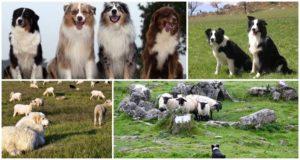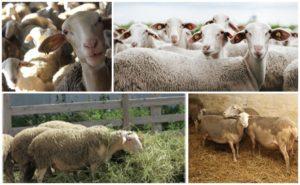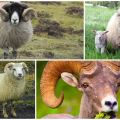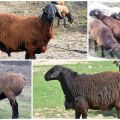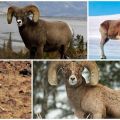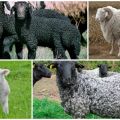Habitat and fitness traits of bighorn sheep, what they eat
Some experts do not define the bighorn sheep as a special species, but consider it a subspecies of the bighorn sheep, but, according to others, it is a separate species of artiodactyls, belonging to the genus of rams. It lives in Eastern Siberia, belongs to the frequently occurring animals that are not threatened with extermination or significant decrease in numbers due to human activities or climatic changes.
Appearance and characteristics
The bighorn sheep is an animal of medium size, with a dense, strong constitution, a small, rather "dry" head with short ears, located on a short and thick neck. The horns of the males are large, wide at the base, twisted in a sharp spiral with the ends directed outward. Females have shorter horns with smaller dimensions, without a spiral design.
Animals have short, massive limbs. Males differ in weight from 56 to 150 kilograms, growth from 76 to 112 centimeters when measured at the withers. Females are smaller - from 33 to 68 kilograms, 76-100 centimeters tall.
The largest snow chubuki live in Chukotka and Kamchatka.
Types of bighorn sheep
The following types of bighorn sheep are distinguished, which also often have a bighorn sheep or shank:
- Okhotsk.
- Koryaksky.
- Putoransky.
- Kolymsky.
- Kamchatsky.
- Yakut.
- Apple.
- Kodarsky (living in isolation on the Kodar plateau of the Olekminsky highlands).
This classification refers to the distribution of artiodactyl species in the area, since they do not have a single habitat - the places where these animals are found are mosaic. This means that separate groups were formed and developed in different places with slightly different conditions, and therefore formed different subspecies. However, the differences are not so significant that they have significant differences.
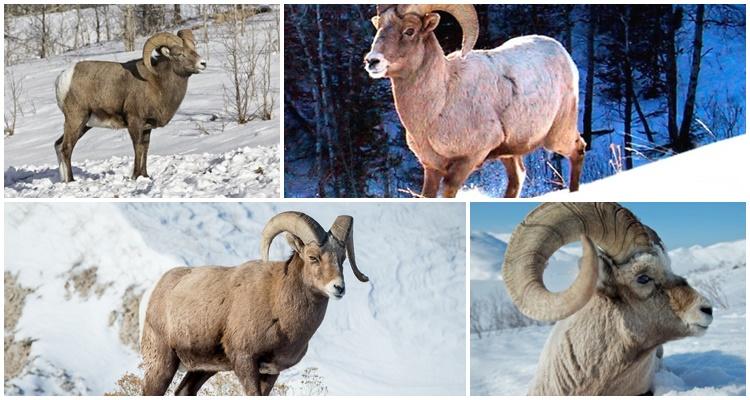
Habitat and habitats
Bighorn sheep are considered mountain animals, but they do not live directly on mountain peaks, but keep within the vegetation zone, that is, they do not rise above 1300 meters. The main habitat is mountain tundra and foothills with a relatively mild climate and snow cover up to 30-40 centimeters. The southern border of the range runs along the Aldan Highlands, in the west - along the mountains beyond Vitim. The northern and eastern borders practically coincide with the coast of Chukotka, the Bering Strait and the Kamchatka Peninsula. The bighorn sheep lives in mountainous areas along the largest East Siberian rivers, on the Putorana plateau.
Current population, movement
At the moment, the total number of snow bighorn horns of all species ranges from 40 to 100 thousand individuals. It is difficult to give an exact figure due to the scattering of individual herds in vast, inaccessible territories and the complexity of the relief and climate.
Snow animals do not roam over long distances, although in search of food they constantly move within their range. Despite their physique and short legs, bighorn sheep run well, although they do not differ in high speed. They jump easily and move over rough terrain. In cold weather, they have to travel considerable distances, as this is associated with the search for food. Under a layer of snow they have to collect the scarce vegetation of the tundra, so they need to walk much more than in summer, when there is a lot of fresh grass and foliage.
The main fitness features of bighorn sheep are their "camouflage" coloration. The fur of animals has various shades of brown, gray and black, which makes them invisible against the backdrop of rocks or bare tundra. However, snow-covered surfaces instantly reveal their location to predators, so we can only talk about relative fitness.
The constitution of the shanks is suitable for driving on mountainous terrain, rocks, for overcoming slopes, uneven areas, cliffs. They can jump up to 3 meters, are enduring and adaptable to modest pastures and low temperatures.
What do they eat?
Snow bighorn sheep need abundant nutritious food to survive in harsh conditions. That is why the body of these animals is adapted to absorb not only tender fresh grass, but also coarser dry shoots, old vegetation, branches, foliage, moss, bark of shrubs and trees, which they can reach.
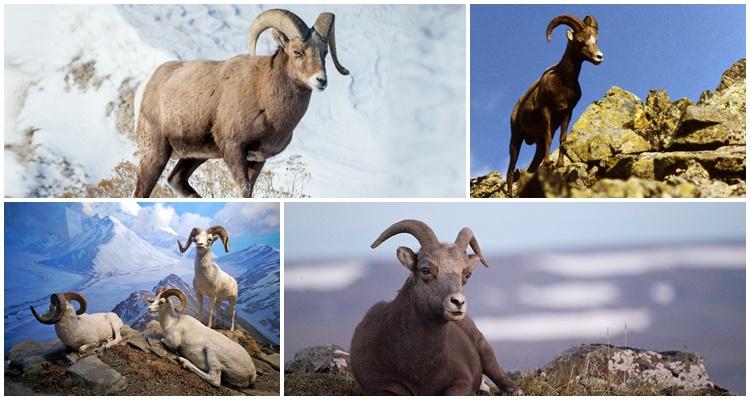
In autumn, the bighorn sheep successfully feeds on berries and mushrooms, not disdaining old, overripe and wormy ones. Eaten grubs and bugs refuse an excellent protein "feed" in severe hungry times.
Natural enemies
In nature, the main danger to bighorn sheep is their habitat with unpredictable weather changes, fogs, snow storms, severe cold, winds and humidity. Also, animals can get into dangerous situations, falling off rocks, falling into rivers or getting stuck in swamps. A lot of trouble is caused by the gnat, which literally eats all living things alive.
But all this refers to natural threats that bighorn sheep have successfully learned to bypass and avoid. Only wolves and wolverines hunt artiodactyls, but bighorn sheep are not very easy and simple prey. They still need to be tracked down and caught, therefore, most often old, sick individuals, pregnant females and weak young animals become victims.
The main predator that threatens protected species of bighorn sheep is humans. The indigenous peoples of Siberia and the North approached their prey wisely, prohibiting the hunt for females and cubs and limiting consumption to certain times of the year, rationing the number of killed animals.
When hunting ceased to be a means of food and became an entertainment, the number of sheep went down sharply. Because of this, Putorana bighorns were included in the Red Book, and the shooting of some varieties of Yakut shanks is strictly limited.
Reproduction and offspring
In summer, with an abundance of food, the herd can reach 30-40 individuals. During the breeding season, in mid-November, it breaks up into groups of 6 females and 2-3 males. Female pregnancy lasts up to 5 months.For childbirth, she leaves the herd and retires in a specially prepared secluded den, where she gives birth to one cub.
Feeding lasts a month, after which the lamb becomes independent and switches to feeding on "adult" food.
Rams reach sexual maturity by the age of 7 years. Due to competition, young animals are driven out of the herd and form their own group.
Conservation works
Now only two subspecies of the bighorn sheep are protected: the Yakut, which is not threatened with complete destruction, but in need of protection, and the Putorana, living in the reserve of the same name on the Putoran plateau. This is a rare animal, so any action against it is a violation of the law.
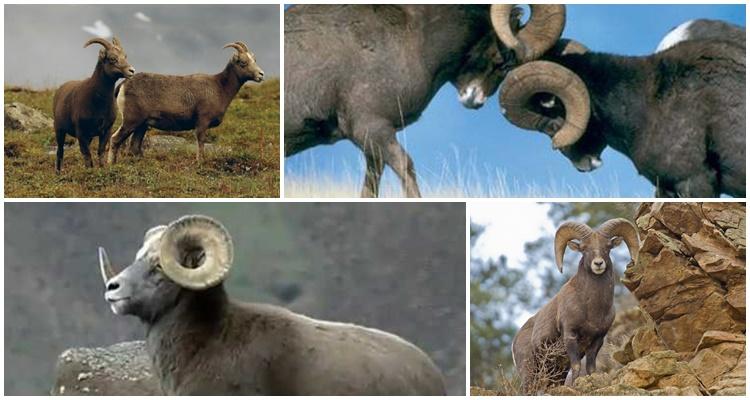
The Yakut variety of the bighorn sheep lives on the Chukotka Peninsula. Its population suffered mainly from negative weather conditions, developed reindeer husbandry and disturbance by human activities, therefore, to protect it, it is enough to provide the herds with comfortable living conditions, and their number will begin to grow. With Putorana rams, experiments were carried out on crossing with other varieties and species of similar animals, but genetic discrepancies so far prevent the breeding of a viable and viable hybrid.
Bighorn sheep in human economic activity
One of the reasons for the decline in the number of bighorn sheep was the active economic activity of humans. Expansion of arable land, pasture and farmland increases competition and leads to a decrease in the number of wild animals.
To protect bighorn sheep, it is important not only to fight poaching, but also to create protective zones, reserves, conduct educational work and preserve the gene pool of rare species in specially created reserves.
Food quality
Bighorn sheep meat is lean, somewhat tough and sinewy, but tasty. It practically does not differ in nutritional value and composition from the meat of domestic sheep, therefore it is prepared according to similar recipes. It can be fried, stewed, baked, served with a variety of side dishes, and also pickled. The flesh of young lambs has an ideal taste and tenderness. Bighorn sheep are graceful animals that need the protection and patronage of humans to maintain their numbers.



